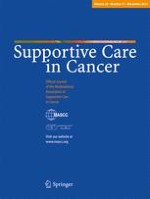Published in:

01-11-2012 | Short Communication
High incidence of bloodstream infection detected by surveillance blood cultures in hematology patients on corticosteroid therapy
Authors:
A. Joosten, J. Maertens, J. Verhaegen, T. Lodewyck, E. Vermeulen, K. Lagrou
Published in:
Supportive Care in Cancer
|
Issue 11/2012
Login to get access
Abstract
Purpose
The aim of our study was to evaluate the frequency of “occult” bacteremia/fungemia as well as the diversity of pathogens involved in hematology patients treated with corticosteroids.
Methods
Daily surveillance blood cultures were taken from patients treated with corticosteroids as part of their intensive chemotherapy or during graft-versus-host disease following hematopoietic stem cell transplantation during a 3-year period (2006–2009). We reviewed the frequency of occult bacteremia/fungemia as well as the pathogens involved.
Results
During the 3-year period, 3,821 bottles were cultured from 215 patients and 4.9 % of the bottles tested were positive. Surveillance blood cultures revealed bloodstream infection in 24 % of the patients (definite bloodstream infection in 16 %). Seventy-five percent of patients were still afebrile when microorganisms were detected. The main risk group was acute lymphocytic leukemia patients undergoing remission induction chemotherapy. The pathogens cultured most frequently were coagulase-negative staphylococci, enterococci, Escherichia coli, and Pseudomonas aeruginosa.
Conclusions
A high incidence of occult bacteremia was detected by surveillance blood cultures. Further studies are needed to evaluate if a strategy based on surveillance blood cultures can reduce mortality related to bloodstream infections.